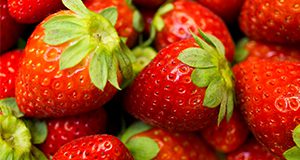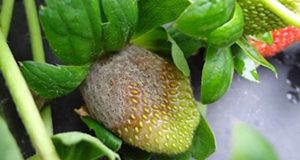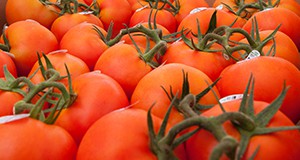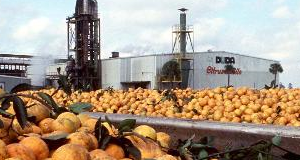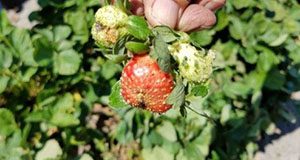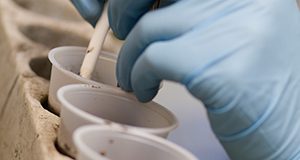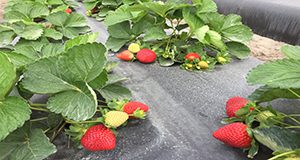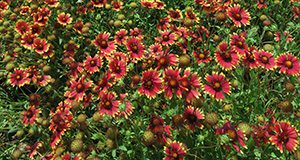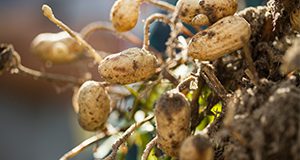Florida has the largest winter strawberry production in the United States. In recent years, Florida's industry has faced growing competition from Mexico. This 5-page fact sheet written by Feng Wu, Zhengfei Guan, and Melvin Garcia-Nazaraiega and published by the UF/IFAS Food and Resource Economics Department compares labor costs between Florida’s and Mexico’s strawberry industries.
http://edis.ifas.ufl.edu/fe1023
Category: Crops
Import Growth and the Impact on the Florida Strawberry Industry
The United States is the second largest producer of strawberries after China, and Florida, along with California, accounts for about 98% of the total US production. In recent years, the US strawberry industry has become increasingly concerned with competition from Mexico. This 3-page fact sheet written by Zhengfei Guan, Dong Hee Suy, Hayk Khachatryan, and Feng Wu and published by the UF/IFAS Food and Resource Economics Department describes the impact of imported strawberries on the Florida strawberry industry and explains how the industry can adapt to meet the challenge.
http://edis.ifas.ufl.edu/fe1022
Charcoal Rot of Strawberries Caused by Macrophomina phaseolina
Charcoal rot is caused by Macrophomina phaseolina and has become more prevalent in Florida strawberry fields since methyl bromide was phased out. This 4-page publication describes the symptoms, development, and control of charcoal rot in strawberry fields. Written by N. A. Peres, J. S. Baggio, and J. C. Mertely and published by the UF/IFAS Department of Plant Pathology, February 2018.
http://edis.ifas.ufl.edu/pp161
Botrytis Fruit Rot or Gray Mold of Strawberry
Botrytis fruit rot (BFR), also known as gray mold, is caused by the fungus Botrytis cinerea and is one of the most important diseases of strawberry in Florida and worldwide. This 4-page document describes the symptoms and management of BFR among strawberry plants. Written by J. C. Mertely, M. S. Oliveira, and N. A. Peres and published by the UF/IFAS Department of Plant Pathology, February 2018.
http://edis.ifas.ufl.edu/pp152
CRISPR: A Technical Breakthrough for Tomato Research
CRISPR is a contemporary biological technology that has attracted the interest of both the science community and the general public. This 4-page article discusses why tomato researchers are interested in CRISPR, what tomato traits have been targeted by CRISPR, and potential applications of CRISPR for tomato genetics and breeding. Written by Tong Geon Lee and published by the UF/IFAS Department of Horticultural Sciences, February 2018.
http://edis.ifas.ufl.edu/hs1314
An Overview of Strawberry Production in Mexico
This 5-page fact sheet written by Feng Wu, Zhengfei Guan, J. Jaime Arana-Coronado and Melvin Garcia-Nazariega and published by the UF/IFAS Food and Resource Economics Department provides an overview of Mexican strawberry production with an emphasis on the production in Central Mexico.
http://edis.ifas.ufl.edu/fe1014
Florida Strawberry Production Costs and Trends
To help growers and policy makers understand how and why strawberry production costs have changed over time, this 5-page fact sheet written by Zhengfei Guan, Feng Wu, and Alicia Whidden and published by the UF/IFAS Food and Resource Economics Department presents cost information collected over a five-year period, analysis of the cost structure of Florida strawberries, and an examination of the trend of changing costs along with the factors underlying the trend.
http://edis.ifas.ufl.edu/fe1013
Fluensulfone: A New "Tool in the Tool Box" to Manage Plant-parasitic Nematodes in Vegetable Production
Plant-parasitic nematodes pose a problem in agricultural systems by feeding on crops, therefore affecting their yield. Fluensulfone is a chemical that can be applied using various methods to manage the impact of plant-parasitic nematodes on crop production. This 6-page document discusses the characteristics and use of fluensulfone as a tool for nematode management practices. Written by Gilma X. Castillo, Monica Ozores-Hampton, and Pablo A. Navia Gine and published by the UF/IFAS Department of Horticultural Sciences, January 2018.
http://edis.ifas.ufl.edu/hs1313
Food Safety on the Farm: Good Agricultural Practices and Good Handling Practices-Packing Operation Sanitation
The ‘Food Safety on the Farm’ series is a collection that reviews the generally recognized principles of GAPs (good agricultural practices) as they relate to produce, primarily at the farm level and with a particular focus on fresh Florida crops and practices. This publication focuses on GAPs and GHPs (good handling practices) relating specifically to packing operation sanitation. Written by Jessica A. Lepper, Aswathy Sreedharan, Renee M. Goodrich-Schneider, and Keith R. Schneider and published by the UF/IFAS Food Science and Human Nutrition Department, December 2017.
http://edis.ifas.ufl.edu/fs189
Foliar or Bud Nematodes in Florida Strawberries
Foliar or bud nematodes are little-known nematodes that caused “crimp disease” in Florida strawberries in the early 1900s. Recently, these foliar nematodes have been observed again in the state, and seem to have come in with transplants from outside Florida. Foliar/bud nematodes can devastate a crop of strawberries. Plants become stunted with curled up leaves, and produce few or no flowers or fruits. This 7-page fact sheet written by J. Desaeger and J. Noling and published by the UF/IFAS Department of Entomology and Nematology provides much-needed information on these little-understood pests, summarizing the different types of foliar nematodes, their biology, life cycle, damage symptoms, survival strategies, dissemination, and management options.
edis.ifas.ufl.edu/in1184
UF/IFAS Standardized Nutrient Recommendations for Vegetable Crop Production in Florida
Soil testing is a scientific tool for effective nutrient management that provides an estimate or an index of the available nutrient-supplying capacity of the soil. This 9-page publication presents the fertilization recommendations for vegetable crops based on soil tests performed by the IFAS Extension Soil Testing Laboratory (ESTL). Written by Rao Mylavarapu, George Hochmuth, and Guodong Liu and published by the UF/IFAS Department of Soil and Water Sciences, December 2017.
http://edis.ifas.ufl.edu/cv002
Tospovirus-Resistant Tomato Varieties for Southern Florida
Tospoviruses are plant-infecting viruses, with three tosposvirus species being particularly relevant to Florida tomato production: Tomato spotted wilt virus, Tomato chlorotic spot virus, and Groundnut ringspot virus. This 5-page document describes the performance of several tospovirus-resistant tomato hybrids based on grower trials in the Homestead, FL production area. Written by Rebecca L. Wente, Samuel F. Hutton, Scott Adkins, William Turechek, and Joseph Funderburk and published by the UF/IFAS Horticultural Sciences Department, December 2017.
http://edis.ifas.ufl.edu/hs1311
Micronutrients Considerations for Warm-Season Forage Grass Systems in Florida
 Warm-season grasses are vital to livestock production systems and dominate ground cover in tropical and subtropical areas. The objective of this 7-page publication is to provide basic information about the role of micronutrients in warm-season grass production systems in Florida. Written by Jane C. Griffin, Joao Vendramini, Diane Rowland, and Maria L. Silveira and published by the UF/IFAS Agronomy Department, November 2017.
Warm-season grasses are vital to livestock production systems and dominate ground cover in tropical and subtropical areas. The objective of this 7-page publication is to provide basic information about the role of micronutrients in warm-season grass production systems in Florida. Written by Jane C. Griffin, Joao Vendramini, Diane Rowland, and Maria L. Silveira and published by the UF/IFAS Agronomy Department, November 2017.
http://edis.ifas.ufl.edu/ag419
'Florida Beauty' Strawberry
‘Florida Beauty’ is a new strawberry cultivar released by the University of Florida and commercialized in 2017. This 4-page document describes the characteristics, performance, growth, and management of this cultivar. Written by Vance M. Whitaker, Natalia A. Peres, and Shinsuke Agehara and published by the UF/IFAS Horticultural Sciences Department, November 2017.
http://edis.ifas.ufl.edu/hs1307
2016 Evaluation of Foliar Fungicides for Disease Control in Peanut in Jay, FL
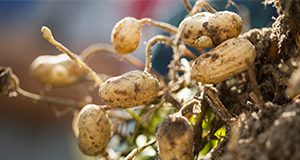 This report includes a summary of the 2016 foliar fungicide programs for control of early and late leaf spot and white mold (southern stem rot) in peanut at Jay, Florida. It shows the effectiveness of 13 fungicide programs for disease control. This 6-page fact sheet discusses fungicide treatments, treatment rates, application timing, 2016 growing conditions, experimental design, and results. Written by Michael Mulvaney, Robert Kemerait, John Atkins, and Nicholas Dufault, and published by the UF Agronomy Department, April 2017.
This report includes a summary of the 2016 foliar fungicide programs for control of early and late leaf spot and white mold (southern stem rot) in peanut at Jay, Florida. It shows the effectiveness of 13 fungicide programs for disease control. This 6-page fact sheet discusses fungicide treatments, treatment rates, application timing, 2016 growing conditions, experimental design, and results. Written by Michael Mulvaney, Robert Kemerait, John Atkins, and Nicholas Dufault, and published by the UF Agronomy Department, April 2017.
http://edis.ifas.ufl.edu/ag415
A Guide to Planting Wildflower Enhancements in Florida
The establishment of native wildflower plantings in Florida can benefit agricultural producers as well as native pollinators and other beneficial insects. Wildflowers provide forage and nesting sites for bees, butterflies, and other pollinators, increasing wild bee numbers across the farm, and increasing natural enemies of insect pests. This 6-page fact sheet written by Mary C. Bammer, Josh Campbell, Chase B. Kimmel, James D. Ellis, and Jaret Daniels and published by the UF/IFAS Department of Entomology and Nematology discusses choosing the right mix of native plant species to benefit many pollinator species, as well as proper site selection, planting practices, and weed control techniques. Wildflower plots are practical to manage, maximize benefits to wildlife, and fit well into overall agricultural operation management practices.
http://edis.ifas.ufl.edu/in1180
Raising Soil Organic Matter Content to Improve Water Holding Capacity
Just like a sponge, soils with high organic matter (OM) can absorb and hold water during rainfall events and deliver it to plants during dry spells. Water is increasingly becoming the most limited natural resource supporting agriculture, but growers can improve their water storage capacity by raising their soil’s OM content. This 5-page fact sheet demonstrates how soil OM content can help increase water holding capacity of soils and describes the laboratory procedure to measure WHC. Written by Jehangir H. Bhadha, Jay M. Capasso, Raju Khatiwada, Stewart Swanson, and Christopher LaBorde, and published by the UF/IFAS Department of Soil and Water Sciences, October 2017.
http://edis.ifas.ufl.edu/SS661
Sugarcane Cultivars Descriptive Fact Sheet: CPCL 97-2730 and CPCL 00-4111
CPCL 97-2730 and CPCL 00-4111 are emerging sugarcane cultivars in Florida with rapid expansion in last couple of years. Both were ranked among the top 10 sugarcane cultivars in Florida in the 2015 Sugarcane Variety Census (VanWeelden et al. 2016) based on their total acreage. High biomass yield and better rust resistance greatly improve the chances of the cultivars’ adoption by growers. This fact sheet provides basic information and yield and disease information about CPCL 97-2730 and CPCL 00-4111 to assist growers in decision-making related to further expansion of these cultivars. Written by Hardev Sandhu and Wayne Davidson, and published by the UF/IFAS Agronomy Department, May 2017.
http://edis.ifas.ufl.edu/sc103
What Is the ENSO Climatology Tool?
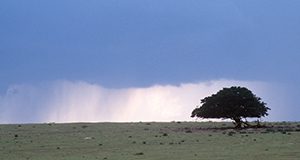 On a global scale, periodic anomalies in sea surface temperatures coupled with shifts in atmospheric pressure and winds, such as those associated with the El Niño Southern Oscillation (ENSO), can have profound impacts on weather conditions. ENSO affects atmospheric circulation patterns well into the midlatitudes and is the leading driver of seasonal climate variability in the United States. Tremendous advances have been made in predicting the occurrence of ENSO events with confidence three to six months in advance. This 5-page fact sheet discusses the ENSO climatology tool as well as possible challenges. Written by Caroline Staub, Clyde Fraisse, Eduardo Gelcer, and Daniel Dourte, and published by the UF Department of Agricultural and Biological Engineering, March 2017.
On a global scale, periodic anomalies in sea surface temperatures coupled with shifts in atmospheric pressure and winds, such as those associated with the El Niño Southern Oscillation (ENSO), can have profound impacts on weather conditions. ENSO affects atmospheric circulation patterns well into the midlatitudes and is the leading driver of seasonal climate variability in the United States. Tremendous advances have been made in predicting the occurrence of ENSO events with confidence three to six months in advance. This 5-page fact sheet discusses the ENSO climatology tool as well as possible challenges. Written by Caroline Staub, Clyde Fraisse, Eduardo Gelcer, and Daniel Dourte, and published by the UF Department of Agricultural and Biological Engineering, March 2017.
http://edis.ifas.ufl.edu/ae522
2012–2016 On-Farm Evaluation of Fungicide Programs for Peanut Disease Control in Hamilton County, Florida
This seven-page fact sheet includes a summary of various fungicide spray programs for fungal disease control of early leaf spot, late leaf spot, and white mold/stem rot of peanut in 2012-2016 on-farm trials in Hamilton County. Written by K.W. Wynn, N.S. Dufault, and R.L. Barocco and published by the Plant Pathology Department.
http://edis.ifas.ufl.edu/pp334
